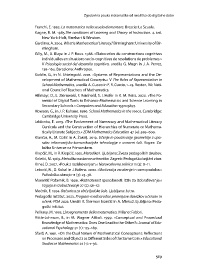Page 569 - Pedagoška vizija / A Pedagogical Vision
P. 569
Zgodovina pouka matematike od neolitika do digitalne dobe
Franchi, E. 1992. La matematica nella scuola elementare. Brescia: La Scuola.
Gagne, R. M. 1985.The conditions of Learning and Theory of Instruction. 4. izd.
New York: Holt, Rinehart & Winston.
Gardiner,A.2004. WhatisMathematicalLiteracy? Birmingham: University of Bir-
mingham.
Gilly, M., A. Blaye in J. P. Roux. 1988. »Elaboration de constructions cognitives
individualles en situations socio-cognitives de resolutions de problemes.«
V Psicologia social del desarollo cognitivo, uredila G. Mugn in J. A. Perrez,
139–164. Barcelona: Anthropos.
Goldin, G., in N. Shteingold. 2001. »Systems of Representations and the De-
velopment of Mathematical Concepts.« V The Roles of Representation in
School Mathematics, uredila A. Cuoco in F. R. Curcio, 1–23. Reston, VA: Nati-
onal Council of Teachers of Mathematics.
Hillmayr, D., L. Ziernwald,F.Reinhold, S.I.Hofer in K. M. Reiss. 2020. »ThePo-
tential of Digital Tools to Enhance Mathematics and Science Learning in
Secondary Schools.« Computers and Education 153:103897.
Howson, G., in J. P. Kahane. 1986. School Mathematics in the 1990s. Cambridge:
Cambridge University Press.
Jablonka, E. 2015. »The Evolvement of Numeracy and Mathematical Literacy
Curricula and the Construction of Hierarchies of Numerate or Mathema-
tically Literate Subjects.« ZDM Mathematics Education 47 (4): 599–609.
Klančar, A., M. Cotič in A. Žakelj. 2019. Učenje in poučevanje geometrije z upo-
rabo informacijsko-komunikacijske tehnologije v osnovni šoli. Koper: Za-
ložbaUniverze naPrimorskem.
Klopčič, M.,inR.Klopčič. 1955. MetodikaI. Ljubljana: Zveza pedagoških društev.
Koletić, M. 1969. Metodika nastavne aritmetike. Zagreb: Pedagoško knjižni zbor.
Krnel, D. 2007. »Pouk z raziskovanjem.« Naravoslovna solnica 11 (3): 8–11.
Lebarič, N.,D.Kobal in J. Kolenc.2002. »Motivacija za učenje in samopodoba.«
Psihološka obzorja 11 (3): 23–38.
Marentič Požarnik, B. 1996. »Raznoterost sposobnosti: izziv za izobraževanje.«
Vzgoja in izobraževanje 27 (2): 56–57.
Močnik, F. 1994. Računica za obče ljudske šole. Ljubljana: Jutro.
Pedagoški inštitut. 2023. Program mednarodne primerjave dosežkov učencev in
učenk: PISA 2022. Uredili K. Šterman Ivančič in A. Mlekuž. Ljubljana: Peda-
goški inštitut.
Pellerey, M. 1995. L’insegnamento della matematica. Milano: Fabbri.
Rittle-Johnson, B., in M. Wagner Alibali. 1999. »Conceptual and Procedural
Knowledge of Mathematics: Does One Lead to the Other?« Journal of Edu-
cational Psychology 91 (1): 175–189.
Sfard, A. 1991. »On the Dual Nature of Mathematical Conceptions: Reflections
on Processes and Objects as Different Sides of the Same Coin.« Educational
Studies in Mathematics 22 (1): 1–36.
569

